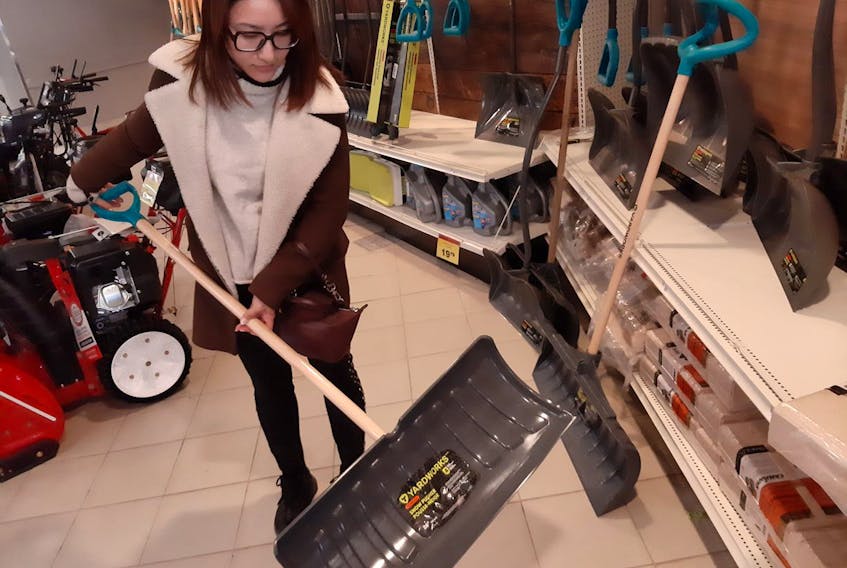Even though our calendars have just flipped over to December, the surprise wintry blast that shut down streets last Thursday and the weather warnings forecast for the upcoming week mean many Nova Scotians will be wielding snow shovels sooner than later.
Clearing walkways and driveways is a chore no one looks forward to, and even less welcome are the potential health risks that could arise from a sudden, intense burst of manual snow removal without the proper precautions or equipment.
Factor in the heavy, wet snow we tend to get on the East Coast — especially when piled in front of the driveway by a passing plow — and a simple shovelling job could result in pain, injury or something even worse.
Dr. Janet MacIntyre is the new chief for the Halifax Infirmary emergency department, and in her experience she annually sees an increased number of injuries coming into the emergency room any time there’s snow. And for the most part, they’re preventable.
The most common are soft tissue and lower back injuries along with fractures and head injuries caused by slipping and falling, and cardiovascular events triggered by the strain of clearing away a driveway full of hundreds of pounds of the white stuff.
“If you add in the cold, that increases the stress level with more exertion, so there’s overexertion causing strain on the heart, especially in individuals that aren’t used to doing prolonged levels of high-intensity exercise,” says MacIntyre.
“If you think you’re at risk, take measures to reduce the chance of overloading your system by using a scoop to push snow instead of lifting, move smaller amounts at a time, or pick a shovel that’s designed to help reduce the workload on the heart.”
Karen Joudrey sits on the executive of the Nova Scotia Society of Occupational Therapists, and is also a practising OT who’s treated her share of patients with pulled muscles, sore shoulders and thrown-out backs after being in a rush to clear the walk or get to work without thinking about snow shovelling basics.
Taking a few extra moments to be prepared before picking up a shovel makes all the difference, from having the proper footwear for preventing falls to remembering simple tips like lifting with the legs and avoiding any repetitive twisting motions with heavy loads.
“Pay attention to your body, and be honest with yourself about what you can actually do in terms of your own activity tolerance,” says Joudrey, who adds that everyone’s going to have their own approach to shovelling, but can make it less of a pain by taking a few minutes to warm up.
“Do some arm circles, bend over with your knees bent, bring your knees to your chest before you even get out of bed, those are all good exercises you can do first thing in the morning.”

While shovelling, Joudrey says it's natural to experience a certain amount of muscle ache and stiffness afterward, but it's important to use good technique to avoid long-term pain. For example, walking with the load and dumping it uses the legs, which is preferable to straining your back and shoulders by flinging snow as far as you can, or twisting to dump it behind you which is one of the worst moves of all.
“Good footwear is key too, because even if you’re using the best body mechanics in the world, if you slip while you’ve got a load and it causes you to twist, that’s a recipe for an injury,' says Joudrey.
“You can pick up a feather, and twist the wrong way and injure yourself. So if you had a load to that, you’re much more susceptible.”
In the war on snowed-in driveways, Jennifer Chabassol is in the front lines as the seasonal goods manager at the Canadian
Tire outlet in Bayers Lake Business Park. She advises customers on what will work best for their situation, from shovels with curved handles that promote proper hand placement and reduce back strain to pushable scoop shovels for decks and walkways.
On a busy and sunny Black Friday weekend, she’s helping shoppers pick the best available shovel, with tips on how plastic is better than metal (less likely to stick) and why an extendable roof rake is a safe alternative to slipping off an icy ladder.
But she’s also bracing herself for when the nasty stuff hits and the rush is on.
“When the weather is like this, and people are prepping, that’s when I get all kinds of questions,” says Chabassol.
“When it’s storming out, people don’t care what kind of shovel they get. If it scoops snow, they’ll take it. When we run out, people end up buying summer shovels because that’s all that’s left.”
Snow shovelling tips from the N.S. Society of Occupational Therapists:
- Warm up: light stretch before and after
- Reduce lifting; it's better to push than lift snow
- Prevent falls: Wear the right footwear
- Regulate temperature: Dress in layers
- Start early, shovel often; don't try to finish it all at once
- Pace yourself; take breaks
- Drink water; stay hydrated
- Choose a shovel that fits your height/strength
- Wear reflective clothing
- Use good form — feet shoulder-width apart, bend knees and lift with legs, avoid twisting hips and back, space hands apart on handle









